Cohen I.M., Kundu P.K. Fluid Mechanics
Подождите немного. Документ загружается.

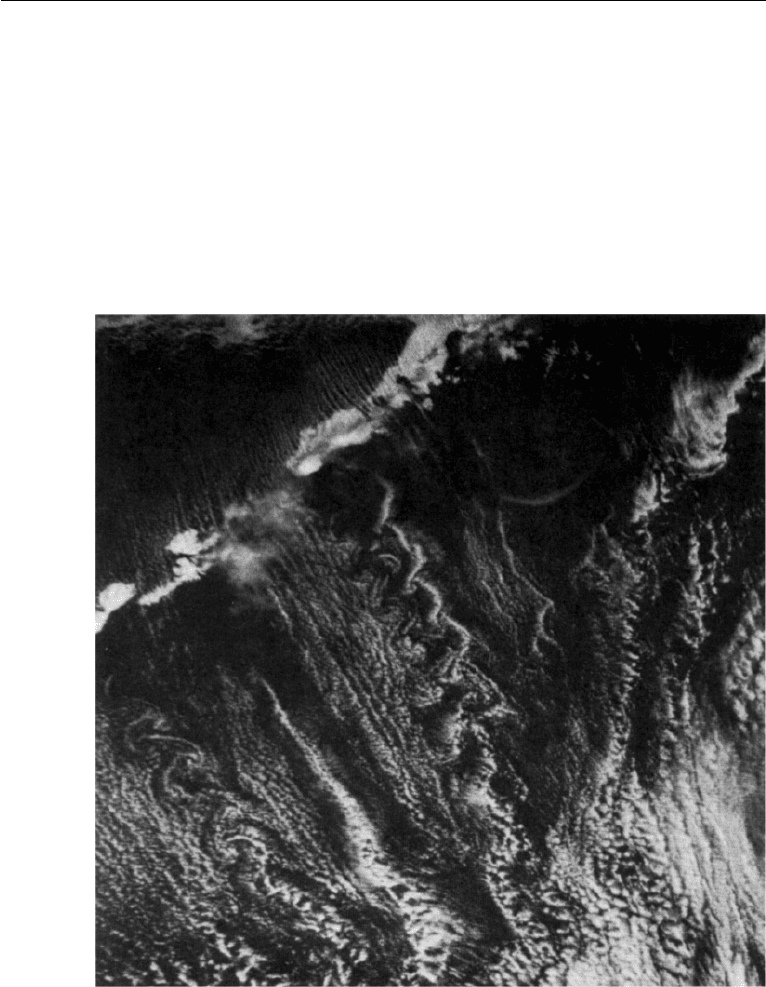
372 Boundary Layers and Related Topics
irregular, and the flow within the vortices themselves becomes chaotic. However, the
flow in the wake continues to have a strong frequency component corresponding to
a Strouhal number of S = 0.21. Above a very high Reynolds number, say 5000, the
periodicity in the wake becomes imperceptible, and the wake may be described as
completely turbulent.
Striking examples of vortex streets have also been observed in the atmosphere.
Figure 10.20 shows a satellite photograph of the wake behind several isolated moun-
tain peaks, through which the wind is blowing toward the southeast. The mountains
pierce through the cloud level, and the flow pattern becomes visible by the cloud
Figure 10.20 A von Karman vortex street downstream of mountain peaks in a strongly stratified atmo-
sphere. There are several mountain peaks along the linear, light-colored feature running diagonally in the
upper left-hand corner of the photograph. North is upward, and the wind is blowing toward the southeast.
R. E. Thomson and J. F. R. Gower, Monthly Weather Review 105: 873–884, 1977, and reprinted with the
permission of the American Meteorlogical Society.
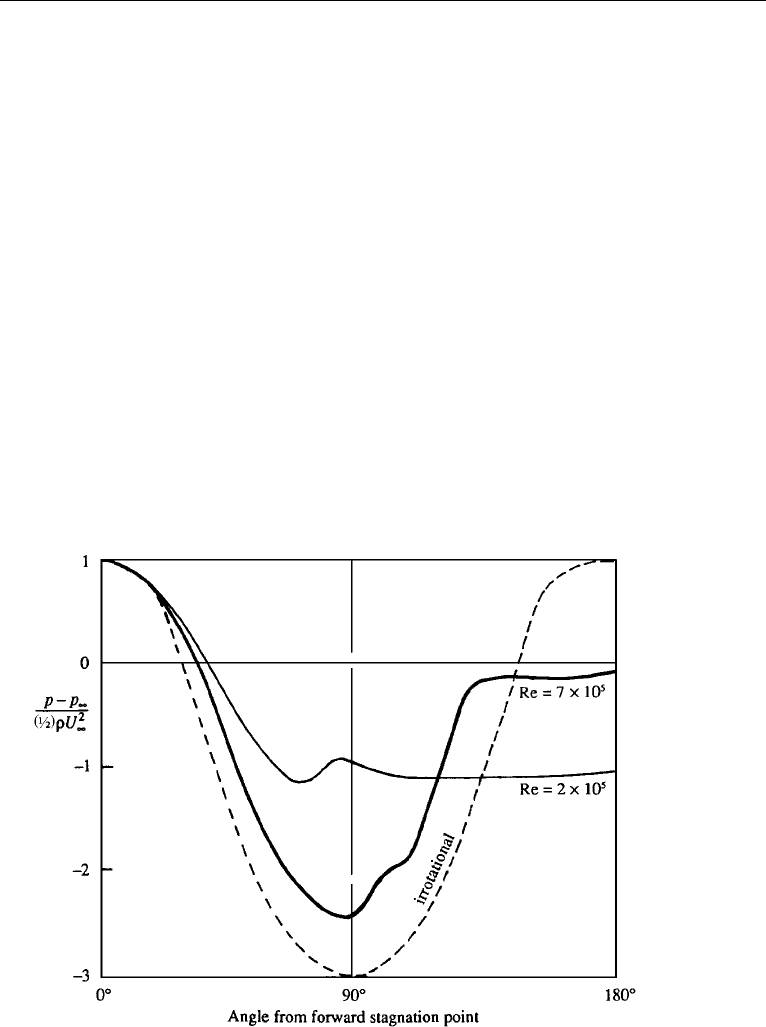
9. Description of Flow past a Circular Cylinder 373
pattern. The wakes behind at least two mountain peaks display the characteristics of a
von Karman vortex street. The strong density stratification in this flow has prevented
a vertical motion, giving the flow the two-dimensional character necessary for the
formation of vortex streets.
High Reynolds Numbers
At high Reynolds numbers the frictional effects upstream of separation are confined
near the surface of the cylinder, and the boundary layer approximation becomes
valid as far downstream as the point of separation. For Re < 3 × 10
5
, the boundary
layer remains laminar, although the wake may be completely turbulent. The laminar
boundary layer separates at ≈82
◦
from the forward stagnation point (Figure 10.17).
The pressure in the wake downstream of the point of separation is nearly constant and
lower than the upstream pressure (Figure 10.21). As the drag in this range is primarily
due to the asymmetry in the pressure distribution caused by separation, and as the
point of separation remains fairly stationary in this range, the drag coefficient also
stays constant at C
D
1.2 (Figure 10.22).
Important changes take place beyond the critical Reynolds number of
Re
cr
∼ 3 ×10
5
(circular cylinder).
Figure 10.21 Surface pressure distribution around a circular cylinder at subcritical and supercritical
Reynolds numbers. Note that the pressure is nearly constant within the wake and that the wake is narrower
for flow at supercritical Re.
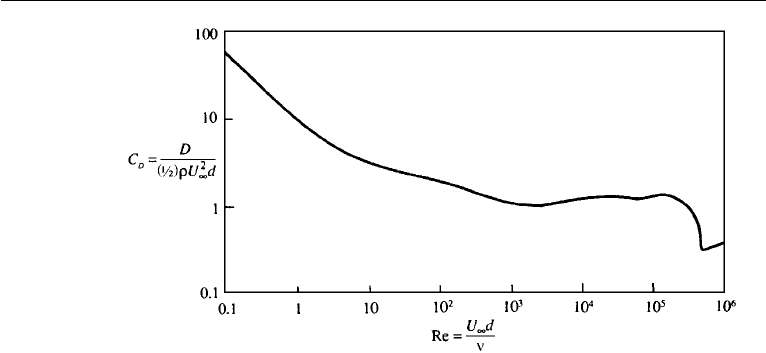
374 Boundary Layers and Related Topics
Figure 10.22 Measured drag coefficient of a circular cylinder. The sudden dip is due to the transition of
the boundary layer to turbulence and the consequent downstream movement of the point of separation.
In the range 3 × 10
5
< Re < 3 ×10
6
, the laminar boundary layer becomes unstable
and undergoes transition to turbulence. We have seen in the preceding section that
because of its greater energy, a turbulent boundary layer, is able to overcome a larger
adverse pressure gradient. In the case of a circular cylinder the turbulent boundary
layer separates at 125
◦
from the forward stagnation point, resulting in a thinner wake
and a pressure distribution more similar to that of potential flow. Figure 10.21 com-
pares the pressure distributions around the cylinder for two values of Re, one with a
laminar and the other with a turbulent boundary layer. It is apparent that the pressures
within the wake are higher when the boundary layer is turbulent, resulting in a sudden
drop in the drag coefficient from 1.2 to 0.33 at the point of transition. For values of
Re > 3 × 10
6
, the separation point slowly moves upstream as the Reynolds number
is increased, resulting in an increase of the drag coefficient (Figure 10.22).
It should be noted that the critical Reynolds number at which the boundary
layer undergoes transition is strongly affected by two factors, namely the intensity
of fluctuations existing in the approaching stream and the roughness of the surface,
an increase in either of which decreases Re
cr
. The value of 3 ×10
5
is found to be
valid for a smooth circular cylinder at low levels of fluctuation of the oncoming
stream.
Before concluding this section we shall note an interesting anecdote about the
von Karman vortex street. The pattern was investigated experimentally by the French
physicist Henri B
´
enard, well-known for his observations of the instability of a layer
of fluid heated from below. In 1954 von Karman wrote that B
´
enard became “jealous
because the vortex street was connected with my name, and several times . . . claimed
priority for earlier observation of the phenomenon. In reply I once said ‘I agree that
what in Berlin and London is called Karman Street in Paris shall be called Avenue
de Henri B
´
enard.’ After this wisecrack we made peace and became good friends.”
von Karman also says that the phenomenon has been known for a long time and is
even found in old paintings.

10. Description of Flow past a Sphere 375
We close this section by noting that this flow illustrates three instances where the
solution is counterintuitive. First, small causes can have large effects. If we solve for
the flow of a fluid with zero viscosity around a circular cylinder, we obtain the results
of Chapter 6, Section 9. The inviscid flow has fore-aft symmetry and the cylinder
experiences zero drag. The bottom two panels of Figure 10.17 illustrate the flow for
small viscosity. For viscosity as small as you choose, in the limit viscosity tends
to zero, the flow must look like the last panel in which there is substantial fore-aft
asymmetry, a significant wake, and significant drag. This is because of the necessity
of a boundary layer and the satisfaction of the no-slip boundary condition on the
surface so long as viscosity is not exactly zero. When viscosity is exactly zero, there
is no boundary layer and there is slip at the surface. The resolution of d’Alembert’s
paradox is through the boundary layer, a singular perturbation of the Navier–Stokes
equations in the direction normal to the boundary.
The second instance of counterintuitivity is that symmetric problems can have
nonsymmetric solutions. This is evident in the intermediate Reynolds number middle
panel of Figure 10.17. Beyond a Reynolds number of ≈40 the symmetric wake
becomes unstable and a pattern of alternating vortices called a von Karman vortex
street is established. Yet the equations and boundary conditions are symmetric about a
central plane in the flow. If one were to solve only a half-problem, assuming symmetry,
a solution would be obtained, but it would be unstable to infinitesimal disturbances
and unlikely to be seen in the laboratory.
The third instance of counterintuitivity is that there is a range of Reynolds num-
bers where roughening the surface of the body can reduce its drag. This is true for
all blunt bodies, such as a sphere (to be discussed in the next section). In this range
of Reynolds numbers, the boundary layer on the surface of a blunt body is laminar,
but sensitive to disturbances such as surface roughness, which would cause earlier
transition of the boundary layer to turbulence than would occur on a smooth body.
Although, as we shall see, the skin friction of a turbulent boundary layer is much
larger than that of a laminar boundary layer, most of the drag is caused by incomplete
pressure recovery on the downstream side of a blunt body as shown in Figure 10.21,
rather than by skin friction. In fact, it is because the skin friction of a turbulent bound-
ary layer is much larger, as a result of a larger velocity gradient at the surface, that
a turbulent boundary layer can remain attached farther on the downstream side of a
blunt body, leading to a narrower wake and more complete pressure recovery and thus
reduced drag. The drag reduction attributed to the turbulent boundary layer is shown
in Figure 10.22 for a circular cylinder and Figure 10.23 for a sphere.
10. Description of Flow past a Sphere
Several features of the description of flow over a circular cylinder qualitatively apply
to flows over other two-dimensional blunt bodies. For example, a vortex street is
observed in a flow perpendicular to a flat plate. The flow over a three-dimensional
body, however, has one fundamental difference in that a regular vortex street is absent.
For flow around a sphere at low Reynolds numbers, there is an attached eddy in the
form of a doughnut-shaped ring; in fact, an axial section of the flow looks similar to
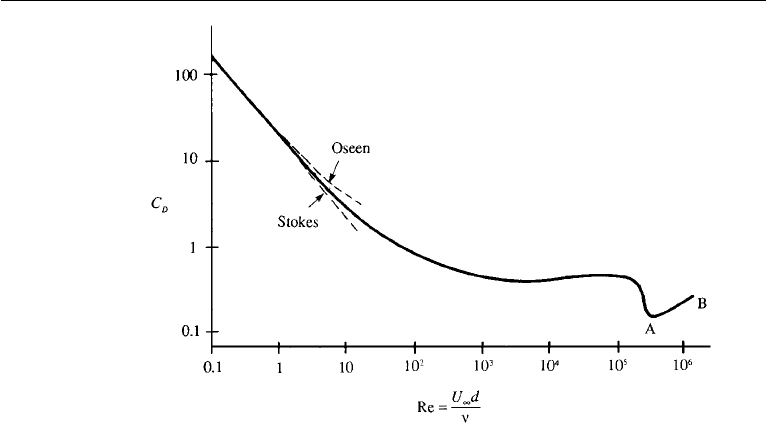
376 Boundary Layers and Related Topics
Figure 10.23 Measured drag coefficient of a smooth sphere. The Stokes solution is C
D
= 24/Re, and the
Oseen solution is C
D
= (24/Re)(1 +3Re/16); these two solutions are discussed in Chapter 9, Sections 12
and 13. The increase of drag coefficient in the range AB has relevance in explaining why the flight paths
of sports balls bend in the air.
that shown in Figure 10.17 for the range 4 < Re < 40. For Re > 130 the ring-eddy
oscillates, and some of it breaks off periodically in the form of distorted vortex
loops.
The behavior of the boundary layer around a sphere is similar to that around
a circular cylinder. In particular it undergoes transition to turbulence at a critical
Reynolds number of
Re
cr
∼ 5 ×10
5
(sphere),
which corresponds to a sudden dip of the drag coefficient (Figure 10.23). As in the
case of a circular cylinder, the separation point slowly moves upstream for postcritical
Reynolds numbers, accompanied by a rise in the drag coefficient. The behavior of the
separation point for flow around a sphere at subcritical and supercritical Reynolds
numbers is responsible for the bending in the flight paths of sports balls, as explained
in the following section.
11. Dynamics of Sports Balls
The discussion of the preceding section could be used to explain why the trajectories
of sports balls (such as those involved in tennis, cricket, and baseball games) bend in
the air. The bending is commonly known as swing, swerve, or curve. The problem has
been investigated by wind tunnel tests and by stroboscopic photographs of flight paths
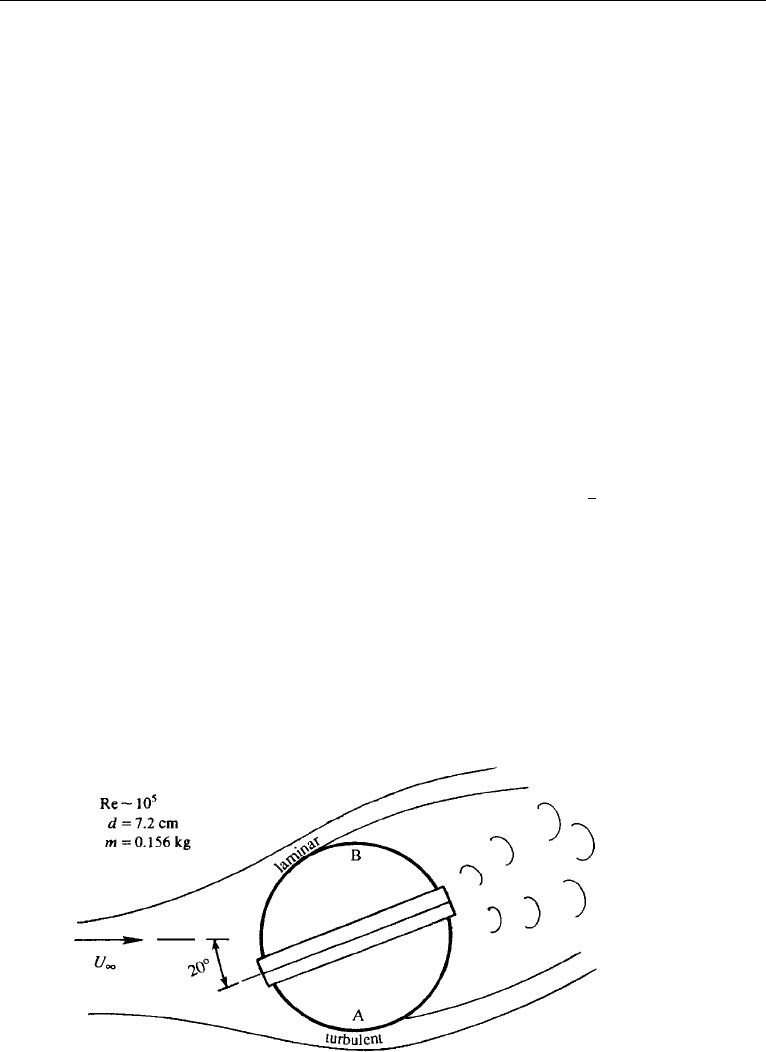
11. Dynamics of Sports Balls 377
in field tests, a summary of which was given by Mehta (1985). Evidence indicates
that the mechanics of bending is different for spinning and nonspinning balls. The
following discussion gives a qualitative explanation of the mechanics of flight path
bending. (Readers not interested in sports may omit this section!)
Cricket Ball Dynamics
The cricket ball has a prominent (1-mm high) seam, and tests show that the orientation
of the seam is responsible for bending of the ball’s flight path. It is known to bend when
thrown at high speeds of around 30 m/s, which is equivalent to a Reynolds number of
Re = 10
5
. Here we shall define the Reynolds number as Re = U
∞
d/ν, based on the
translational speed U
∞
of the ball and its diameter d. The operating Reynolds number
is somewhat less than the critical value of Re
cr
= 5 ×10
5
necessary for transition of
the boundary layer on a smooth sphere into turbulence. However, the presence of the
seam is able to trip the laminar boundary layer into turbulence on one side of the ball
(the lower side in Figure 10.24), while the boundary layer on the other side remains
laminar. We have seen in the preceding sections that because of greater energy a turbu-
lent boundary layer separates later. Typically, the boundary layer on the laminar side
separates at ≈ 85
◦
, whereas that on the turbulent side separates at 120
◦
. Compared
to region B, the surface pressure near region A is therefore closer to that given by the
potential flow theory (which predicts a suction pressure of (p
min
−p
∞
)/(
1
2
ρU
2
∞
) =
−1.25; see equation (6.81)). In other words, the pressures are lower on side A, result-
ing in a downward force on the ball. (Note that Figure 10.24 is a view of the flow
pattern looking downward on the ball, so that it corresponds to a ball that bends to
the left in its flight. The flight of a cricket ball oriented as in Figure 10.24 is called an
“outswinger” in cricket literature, in contrast to an “inswinger” for which the seam is
oriented in the opposite direction so as to generate an upward force in Figure 10.24.)
Figure 10.25, a photograph of a cricket ball in a wind tunnel experiment, clearly
shows the delayed separation on the seam side. Note that the wake has been deflected
upward by the presence of the ball, implying that an upward force has been exerted
Figure 10.24 The swing of a cricket ball. The seam is oriented in such a way that the lateral force on the
ball is downward in the figure.
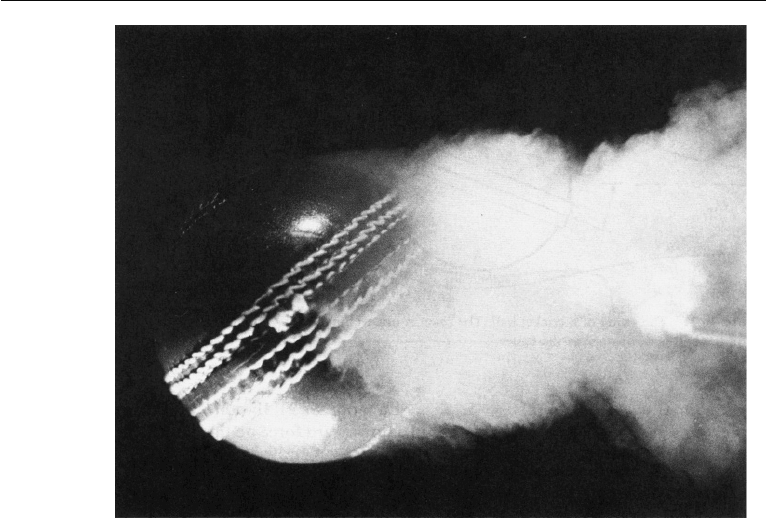
378 Boundary Layers and Related Topics
Figure 10.25 Smoke photograph of flow over a cricket ball. Flow is from left to right. Seam angle is 40
◦
,
flow speed is 17 m/s, Re = 0.85 × 10
5
. R. Mehta, Ann. Rev Fluid Mech. 17: 151–189, 1985. Photograph
reproduced with permission from the Annual Review of Fluid Mechanics, Vol. 17
c
1985 Annual Reviews
www.AnnualReviews.org.
by the ball on the fluid. It follows that a downward force has been exerted by the fluid
on the ball.
In practice some spin is invariably imparted to the ball. The ball is held along the
seam and, because of the round arm action of the bowler, some backspin is always
imparted along the seam. This has the important effect of stabilizing the orientation
of the ball and preventing it from wobbling. A typical cricket ball can generate side
forces amounting to almost 40% of its weight. A constant lateral force oriented in
the same direction causes a deflection proportional to the square of time. The ball
therefore travels in a parabolic path that can bend as much as 0.8 m by the time it
reaches the batsman.
It is known that the trajectory of the cricket ball does not bend if the ball is thrown
too slow or too fast. In the former case even the presence of the seam is not enough
to trip the boundary layer into turbulence, and in the latter case the boundary layer
on both sides could be turbulent; in both cases an asymmetric flow is prevented. It is
also clear why only a new, shiny ball is able to swing, because the rough surface of an
old ball causes the boundary layer to become turbulent on both sides. Fast bowlers in
cricket maintain one hemisphere of the ball in a smooth state by constant polishing.
It therefore seems that most of the known facts about the swing of a cricket ball
have been adequately explained by scientific research. The feature that has not been
explained is the universally observed fact that a cricket ball swings more in humid

11. Dynamics of Sports Balls 379
conditions. The changes in density and viscosity due to changes in humidity can
change the Reynolds number by only 2%, which cannot explain this phenomenon.
Tennis Ball Dynamics
Unlike the cricket ball, the path of the tennis ball bends because of spin. A ball hit
with topspin curves downward, whereas a ball hit with underspin travels in a much
flatter trajectory. The direction of the lateral force is therefore in the same sense as
that of the Magnus effect experienced by a circular cylinder in potential flow with
circulation (see Chapter 6, Section 10). The mechanics, however, are different. The
potential flow argument (involving the Bernoulli equation) offered to account for the
lateral force around a circular cylinder cannot explain why a negative Magnus effect
is universally observed at lower Reynolds numbers. (By a negative Magnus effect we
mean a lateral force opposite to that experienced by a cylinder with a circulation of
the same sense as the rotation of the sphere.) The correct argument seems to be the
asymmetric boundary layer separation caused by the spin. In fact, the phenomenon
was not properly explained until the boundary layer concepts were understood in
the twentieth century. Some pioneering experimental work on the bending paths
of spinning spheres was conducted by Robins about two hundred years ago; the
deflection of rotating spheres is sometimes called the Robins effect.
Experimental data on nonrotating spheres (Figure 10.23) shows that the boundary
layer on a sphere undergoes transition at a Reynolds number of ≈ Re = 5 × 10
5
,
indicated by a sudden drop in the drag coefficient. As discussed in the preceding
section, this drop is due to the transition of the laminar boundary layer to turbulence.
An important point for our discussion here is that for supercritical Reynolds numbers
the separation point slowly moves upstream, as evidenced by the increase of the drag
coefficient after the sudden drop shown in Figure 10.23.
With this background, we are now in a position to understand how a spinning
ball generates a negative Magnus effect at Re < Re
cr
and a positive Magnus effect
at Re > Re
cr
. For a clockwise rotation of the ball, the fluid velocity relative to the
surface is larger on the lower side (Figure 10.26). For the lower Reynolds number
case (Figure 10.26a), this causes a transition of the boundary layer on the lower side,
while the boundary layer on the upper side remains laminar. The result is a delayed
separation and lower pressure on the bottom surface, and a consequent downward
force on the ball. The force here is in a sense opposite to that of the Magnus effect.
The rough surface of a tennis ball lowers the critical Reynolds number, so that
for a well-hit tennis ball the boundary layers on both sides of the ball have already
undergone transition. Due to the higher relative velocity, the flow near the bottom has
a higher Reynolds number, and is therefore farther along the Re-axis of Figure 10.23,
in the range AB in which the separation point moves upstream with an increase of
the Reynolds number. The separation therefore occurs earlier on the bottom side,
resulting in a higher pressure there than on the top. This causes an upward lift force
and a positive Magnus effect. Figure 10.26b shows that a tennis ball hit with under-
spin generates an upward force; this overcomes a large fraction of the weight of the
ball, resulting in a much flatter trajectory than that of a tennis ball hit with topspin.
A “slice serve,” in which the ball is hit tangentially on the right-hand side, curves to
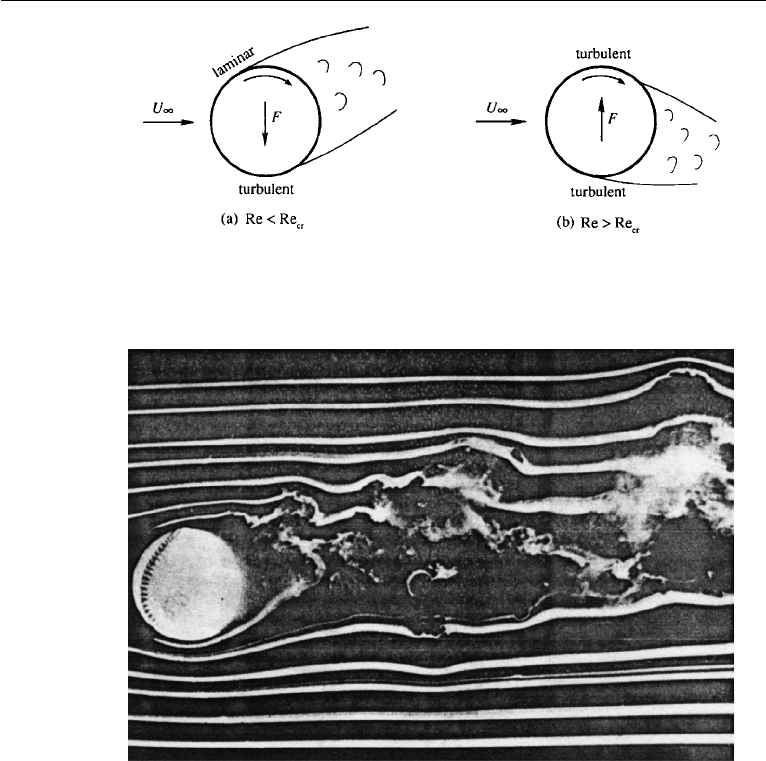
380 Boundary Layers and Related Topics
Figure 10.26 Bending of rotating spheres, in which F indicates the force exerted by the fluid: (a) negative
Magnus effect; and (b) positive Magnus effect. A well-hit tennis ball is likely to display the positive Magnus
effect.
Figure 10.27 Smoke photograph of flow around a spinning baseball. Flow is from left to right, flow
speed is 21 m/s, and the ball is spinning counterclockwise at 15 rev/s. [Photograph by F. N. M. Brown,
University of Notre Dame.] Photograph reproduced with permission, from the Annual Review of Fluid
Mechanics, Vol. 17
c
1985 by Annual Reviews www.AnnualReviews.org.
the left due to the same effect. (Presumably soccer balls curve in the air due to similar
dynamics.)
Baseball Dynamics
A baseball pitcher uses different kinds of deliveries, a typical Reynolds number being
1.5 × 10
5
. One type of delivery is called a “curveball,” caused by sidespin imparted
by the pitcher to bend away from the side of the throwing arm. A “screwball” has
the opposite spin and curved trajectory. The dynamics of this is similar to that of
a spinning tennis ball (Figure 10.26b). Figure 10.27 is a photograph of the flow
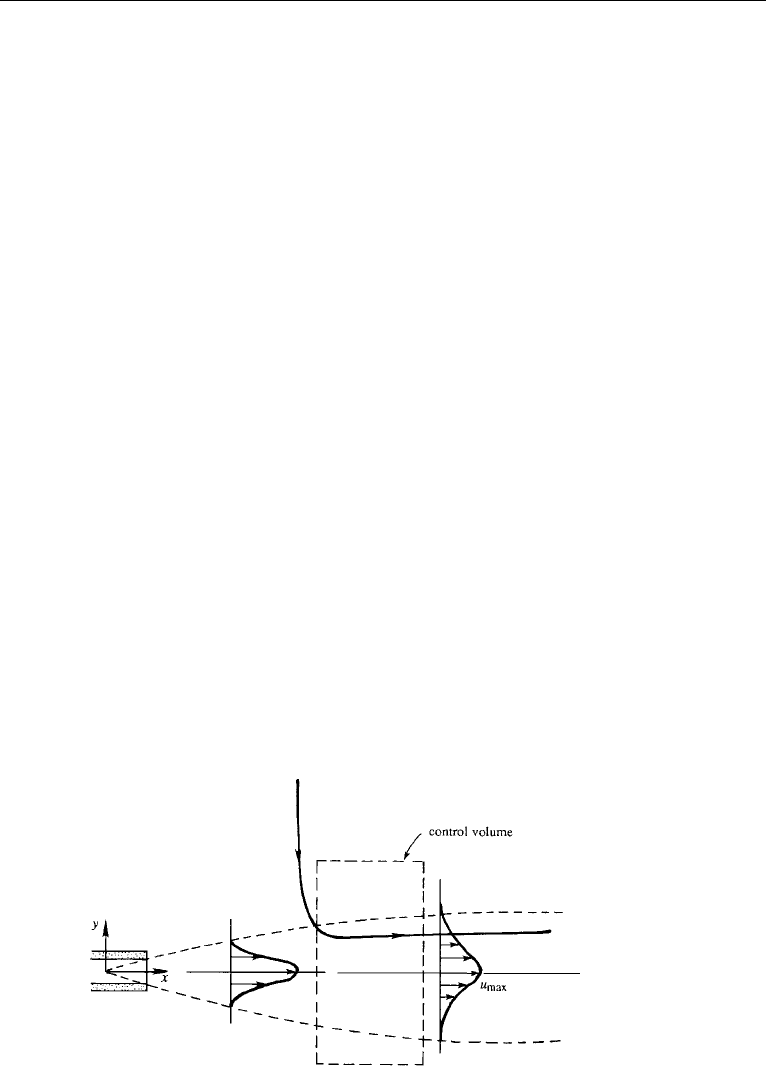
12. Two-Dimensional Jets 381
over a spinning baseball, showing an asymmetric separation, a crowding together of
streamlines at the bottom, and an upward deflection of the wake that corresponds to
a downward force on the ball.
The knuckleball, on the other hand, is released without any spin. In this case
the path of the ball bends due to an asymmetric separation caused by the orientation
of the seam, much like the cricket ball. However, the cricket ball is released with
spin along the seam, which stabilizes the orientation and results in a predictable
bending. The knuckleball, on the other hand, tumbles in its flight because of a lack
of stabilizing spin, resulting in an irregular orientation of the seam and a consequent
irregular trajectory.
12. Two-Dimensional Jets
So far we have considered boundary layers over a solid surface. The concept of
a boundary layer, however, is more general, and the approximations involved are
applicable if the vorticity is confined in thin layers without the presence of a solid
surface. Such a layer can be in the form of a jet of fluid ejected from an orifice, a wake
(where the velocity is lower than the upstream velocity) behind a solid object, or a
mixing layer (vortex sheet) between two streams of different speeds. As an illustration
of the method of analysis of these “free shear flows,” we shall consider the case of
a laminar two-dimensional jet, which is an efflux of fluid from a long and narrow
orifice. The surrounding is assumed to be made up of the same fluid as the jet itself,
and some of this ambient fluid is carried along with the jet by the viscous drag at the
outer edge of the jet (Figure 10.28). The process of drawing in the surrounding fluid
from the sides of the jet by frictional forces is called entrainment.
The velocity distribution near the opening of the jet depends on the details of
conditions upstream of the orifice exit. However, because of the absence of an exter-
nally imposed length scale in the downstream direction, the velocity profile in the
jet approaches a self-similar shape not far from the exit, regardless of the velocity
distribution at the orifice.
Figure 10.28 Laminar two-dimensional jet. A typical streamline showing entrainment of surrounding
fluid is indicated.
